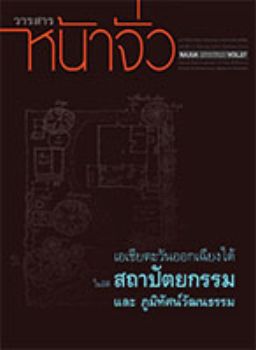ภูมิทัศน์พื้นถิ่นอำเภอเชียงคาน จังหวัดเลย
คำสำคัญ:
เชียงคาน, เลย, สถาปัตยกรรมพื้นถิ่น, Chiang Khan, Loei, Vernacular Landscapeบทคัดย่อ
การศึกษาภูมิทัศน์พื้นถิ่นของอำเภอเชียงคาน จังหวัดเลย มีวัตถุประสงค์ คือ 1) ศึกษาประวัติศาสตร์ ความเป็นมาลักษณะทางกายภาพและวิถีชีวิตของชาวเชียงคาน 2) ศึกษาลักษณะองค์ประกอบและปัจจัยที่ก่อให้เกิดภูมิทัศน์พื้นถิ่นของเชียงคาน เก็บข้อมูลโดยการตรวจเอกสาร สำรวจและสัมภาษณ์ผู้สูงอายุ และคนในชุมชน วิเคราะห์และสรุปผลเชิงพรรณนาร่วมกับภาพร่าง ผลการศึกษาพบว่า เชียงคานมีลักษณะเด่นทางกายภาพคือ เป็นที่ราบตั้งอยูริ่มแม่น้ำโขง โอบล้อมไปด้วยภูเขา คนเชียงคานสืบเชื้อสายมาจากหลวงพระบาง มีวิถีชีวิตแบบไทท่า มีศิลปวัฒนธรรมคล้ายคลึงกับล้านช้างผสมผสานกับคติความเชื่อของคนอีสาน สภาพเศรษฐกิจและสังคมเป็นแบบสังคมการค้าและสังคมเกษตรกรรมเกิดเป็นลักษณะเฉพาะตัวของเชียงคาน คือ รูปแบบการวางผังและสภาพบ้านเรือนที่อยู่อาศัยบริเวณริมนํ้าจะยึดตามแนวของแม่นํ้าเป็นหลัก เส้นทางสัญจรหลักคือ แม่นํ้าโขง มีถนนชายโขงและถนนศรีเชียงคานวางเป็นแนวยาวขนานกับแม่นํ้าโขง มีซอยขนาดเล็กตัดผ่านถนนลงสู่แม่นํ้า เป็นจุดเชื่อมต่อแม่นํ้ากับชุมชนด้านในเข้าด้วยกัน ลักษณะบ้านเรือนแบ่งได้ 2 กลุ่ม คือ 1) บริเวณชุมชนริมนํ้าเป็นบ้านไม้เรือนแถวกึ่งเรือนค้าขาย พืชพรรณที่ปลูกเป็นแบบผสมผสาน เน้นประโยชน์ใช้สอย เช่น ไม้ผลและพืชผักสวนครัว 2) บ้านเรือนในพื้นที่เกษตรกรรมจะตั้งห่างออกไปจากแม่นํ้าโขงเป็นกลุ่มอยู่ริมทางสัญจร หรือเป็นหลังเดี่ยว ลักษณะเป็นบ้านยกพื้นชั้นเดียว การจัดการพื้นที่แบ่งเป็นที่อยู่อาศัย เลี้ยงสัตว์ ทำนา สวนผลไม้แบบผสมผสานอยู่ในบริเวณเดียวกัน
Vernacular Landscape of Chiang Khan District, Loei Province
The study of vernacular landscape of Chiang Khan district in Loei aimed to 1) study Chiang Khan history, physical settings and lifestyle of Chiang Khan people 2) study the elements and factors causing vernacular landscape of Chiang Khan. Data were collected from related literature, field surveys and interviews of the elderly and local people. Descriptive analysis was used together with some sketches. The results showed that the distinct physical settings of Chiang Khan were a plain next to the Mekong River, surrounded by mountains. Chiang Khan people descended from Luang Prabang people and have “Tai Ta” culture. Their culture is similar to that of Lan-Chang, combined with the beliefs of E-sarn people. Economic and social aspects that were based on trade and agriculture had formed a unique settlement pattern. The residential area followed the Mekong River. The main transportation route was the Mekong River, with Chai Khong and Sri Chiang Khan roads, running parallel with the River, as secondary routes. Small lanes connected these roads and led to the River. There were 2 groups of residents: 1) the commercial ones were located along the River. They were shop houses, with mixed kinds of plant for uses rather than beauty and 2) the agricultural ones were located further away from the River. They were either grouped or single. The layout was divided into residential area, animal husbandry, rice field and orchard zones.





